Chapter One
Dangerous Concept, Dangerous Times: Galileo, Kepler and the Church
Page 1The glass used in these early instruments was of very poor quality and chromatic and spherical aberration worsened the images. Despite this astronomers continued to press for ever more powerful instruments. Before the invention of mirror lenses and the perfecting of the reflecting telescope, the only way to improve the actual telescope seemed to be to increase the focal length. The result was tubes so long they threatened to bend under their own weight and supports that became increasingly unstable; tubes were built over thirty metres long, up to Hevelius's gigantic telescope (focal length 45 metres) and the so-called "aerial telescopes" (over 60 metres), achieved by simply placing the object lens in an elevated position and collecting the image in the eyepiece, without using tubes. All at the expense of using these long instruments reasonably. — from the Astronomical Observatory of Bologna article "Telescopes"
Introduction — Early Lens & Magnification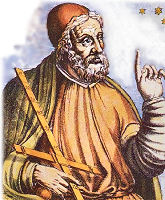 The concept and principles of lens magnification was not a new concept in the 17th century world. The science dated back as far as the mid-2nd century B.C., when Claudius Ptolemy, in the thirteen-book Compositione Matematica or Almagest, discovered the first known mathematical relationship between the angles of the rays of refracted light and incident light. His work, written after research into the properties of light and colors, were part of his treatise of five books under the title Optics. This was followed in the 1st Century A.D. by Seneca (c. 62 A.D.), who described a means of magnification through the use of a glass filled with water: Letters, however small and indistinct, are seen enlarged and more clearly through a globe of glass filled with water. The principle behind Seneca's discovery of magnification is known as refraction, or the bending of light as it passes through one medium into another of different density; a glass vessel filled with water in this case. To the famous Greek mathematician Euclid, the properties of magnification were also known. In his treatise entitled Optica, written in c.300 B.C., he noted: Things under a larger angle appear larger, those under a smaller angle appear smaller, and those under equal angles appear equal. While it is clear that the ancients knew of the properties of magnification and its possible use, there is no evidence that any type of visual aid was ever effected by them. Seen above left is an image of Claudius Ptolemy from Michael Lahanas' article "Astronomy of Ptolemy". [1]
The concept and principles of lens magnification was not a new concept in the 17th century world. The science dated back as far as the mid-2nd century B.C., when Claudius Ptolemy, in the thirteen-book Compositione Matematica or Almagest, discovered the first known mathematical relationship between the angles of the rays of refracted light and incident light. His work, written after research into the properties of light and colors, were part of his treatise of five books under the title Optics. This was followed in the 1st Century A.D. by Seneca (c. 62 A.D.), who described a means of magnification through the use of a glass filled with water: Letters, however small and indistinct, are seen enlarged and more clearly through a globe of glass filled with water. The principle behind Seneca's discovery of magnification is known as refraction, or the bending of light as it passes through one medium into another of different density; a glass vessel filled with water in this case. To the famous Greek mathematician Euclid, the properties of magnification were also known. In his treatise entitled Optica, written in c.300 B.C., he noted: Things under a larger angle appear larger, those under a smaller angle appear smaller, and those under equal angles appear equal. While it is clear that the ancients knew of the properties of magnification and its possible use, there is no evidence that any type of visual aid was ever effected by them. Seen above left is an image of Claudius Ptolemy from Michael Lahanas' article "Astronomy of Ptolemy". [1]-fn1
 The most outstanding contribution in early optical science came from the experimental research work of the Egyptian Abu Ali Hasan who described the power of magnification and the refraction of light in his treatise entitled Kitab-al-Manadhir. This work, which contained seven essays on optics, was known as the Opticae Thesaurus, and it had a great influence upon Western thinking, seeing wide usage as a reference source by many European scientists, including Roger Bacon and Johannes Kepler.
The most outstanding contribution in early optical science came from the experimental research work of the Egyptian Abu Ali Hasan who described the power of magnification and the refraction of light in his treatise entitled Kitab-al-Manadhir. This work, which contained seven essays on optics, was known as the Opticae Thesaurus, and it had a great influence upon Western thinking, seeing wide usage as a reference source by many European scientists, including Roger Bacon and Johannes Kepler.Hasan, who was also known to Europeans by the name "Alhazen", is best remembered for suggesting the use of a lens to help vision and as the first to describe accurately the various parts of the eye while giving a scientific explanation of the process of sight. He correctly concluded that vision originates from rays sent by an object to the eye and not by rays emanating from the eye itself, as was theorized by both Ptolemy and Euclid. Hasan also went on to explain the details of binocular vision and gave a correct explanation for the apparent increase in size of the sun and the moon when near the horizon. As a result of Hasan's methodical analysis of the action of light and lenses, his works were translated into Latin in 1270, over a century after his death, allowing European researchers to follow up and expand upon his ideas. Seen above right is an image of Abu Ali Hasan Ibn al-Haitham 965 A. D. — 1040 A.D. from Wikipedia [2]
Around 1268 the English philosopher and champion of experimental science, Roger Bacon, recorded a reference to the magnifying properties of lenses; it was shortly thereafter that spectacle devices began to appear in Europe. Credit for the invention is usually given to Alessandro di Spina, a monk who died at Pisa in 1313, and to Salvino degli Amati (D'Armate), who died at Florence in 1317. As Richard D. Drewry, Jr., M. D. writes in his article on the history of eyeglasses:
In the year 1268, Roger Bacon, the English philosopher, wrote in his Opus Majus: "If anyone examine letters or other minute objects through the medium of crystal or glass or other transparent substance, if it be shaped like the lesser segment of a sphere, with the convex side toward the eye, he will see the letters far better and they will seem larger to him. For this reason such an instrument is useful to all persons and to those with weak eyes for they can see any letter, however small, if magnifier enough. [3]
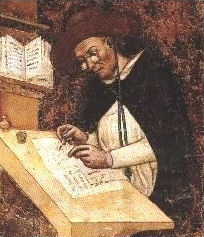 I am so debilita-ted-by age that without the glasses known as spectacles, I would no longer be able to read or write. These have recently been invented for the benefit of poor old people whose sight has become weak. So wrote Sandra di Popozo in a 1289 manuscript entitled Traite de con uite de la famille. This was followed some years later by a monk named Giordano de Pisa, who delivered a Lent sermon on 23 February 1305 in which he stated: It is not yet twenty years since the art of making spectacles, one of the most useful arts on earth, was discovered. I, myself, have seen and conversed with the man who made them first. Then, in 1352, a portrait of Cardinal Hugh of Provence, shown at left, was painted by Tommaso da Modena in which he is clearly seen wearing spectcles. Notes the Il Capitolo dei Domenicani (The Cycle of the Dominicans) website: This portrait is famous because it is the first time that spectacles were painted and includes the smallest of details, such as the screw which holds them on his nose and allows them to be folded up. [4]
I am so debilita-ted-by age that without the glasses known as spectacles, I would no longer be able to read or write. These have recently been invented for the benefit of poor old people whose sight has become weak. So wrote Sandra di Popozo in a 1289 manuscript entitled Traite de con uite de la famille. This was followed some years later by a monk named Giordano de Pisa, who delivered a Lent sermon on 23 February 1305 in which he stated: It is not yet twenty years since the art of making spectacles, one of the most useful arts on earth, was discovered. I, myself, have seen and conversed with the man who made them first. Then, in 1352, a portrait of Cardinal Hugh of Provence, shown at left, was painted by Tommaso da Modena in which he is clearly seen wearing spectcles. Notes the Il Capitolo dei Domenicani (The Cycle of the Dominicans) website: This portrait is famous because it is the first time that spectacles were painted and includes the smallest of details, such as the screw which holds them on his nose and allows them to be folded up. [4]-fn2
By the mid Fourteenth century, the European spectacle industry could boast of having a fairly stable market amongst the well-educated, very rich and influential noblemen as well as the extremely well-read Italian clergy. This trend, started in Pisa was, by the Fifteenth century, a well entrenched market in Florence, a city that took the led in innovation, production, sale, and the spread of spectacles within and outside of Italy, and though the lenses were at the heart of future telescopic technology, there seems to have been little to no further development or application of the optics in this direction until the very late Sixteenth or early Seventeenth centuries.
Unveiling The Invention
O telescope, instrument of knowledge, more precious than any sceptre. — Johannes Kepler, in a letter to Galileo (1610)
October 1608 — Hans Lippershey, Jacob Metius and the Telescope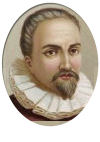 In Holland, early in the Seventeenth century, an optical instrument was unveiled which could magnify objects that were off in the distance, whether it was land or sky. Though it has been debated, credit for the telescope's invention is given to Hans Lippershey (c.1570-1619) of Holland (seen left), who applied for a patent to the States General of the Netherlands for such a device in 1608. While little is know of Lippershey's early life, he was a German-born spectacle maker who settled in the south-western city of Middelburg,
In Holland, early in the Seventeenth century, an optical instrument was unveiled which could magnify objects that were off in the distance, whether it was land or sky. Though it has been debated, credit for the telescope's invention is given to Hans Lippershey (c.1570-1619) of Holland (seen left), who applied for a patent to the States General of the Netherlands for such a device in 1608. While little is know of Lippershey's early life, he was a German-born spectacle maker who settled in the south-western city of Middelburg, 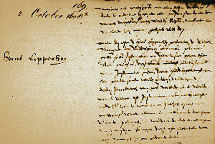 the Netherlands in 1594, becoming a citizen of that country in 1602. As to the invention of his telescope, while several anecdotes regarding the process of his discovery exist, what Lippershey did was to set two lenses in line to one another, finding that this combination produced an image that was much magnified. It wasn't long before he placed the two lenses in a tube in order to make it easier to use and hence, developed the first version of a telescope. Lippershey called his invention a "kijker", meaning "looker" in Dutch and in 1608, applied for a patent on the device with the States General. Shown at right is the Minute Book of the States General of the Netherlands showing the Patent Application of Hans Lippershey and dated 17 October 1608. Courtesy Algemeen Rijksarchief, The Hague, MSS "Staten-Generaal," Vol. 33, f. 178v. Copyright, Algemeen Rijksarchief.
the Netherlands in 1594, becoming a citizen of that country in 1602. As to the invention of his telescope, while several anecdotes regarding the process of his discovery exist, what Lippershey did was to set two lenses in line to one another, finding that this combination produced an image that was much magnified. It wasn't long before he placed the two lenses in a tube in order to make it easier to use and hence, developed the first version of a telescope. Lippershey called his invention a "kijker", meaning "looker" in Dutch and in 1608, applied for a patent on the device with the States General. Shown at right is the Minute Book of the States General of the Netherlands showing the Patent Application of Hans Lippershey and dated 17 October 1608. Courtesy Algemeen Rijksarchief, The Hague, MSS "Staten-Generaal," Vol. 33, f. 178v. Copyright, Algemeen Rijksarchief.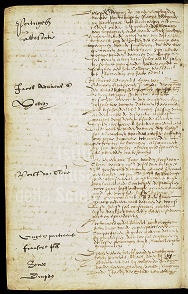 According to Louis Bell, in his definitive work, The Telescope: "The States General pricked up its ears and promptly appointed on Oct. 4 a committee to test the new instrument from a tower of Prince Maurice's palace, allotting 900 florins for the purchase of the invention should it prove good. On the 6th the committee reported favorably and the Assembly agreed to give Lippershey 900 florins for his instrument, but desired that it be arranged for use with both eyes." [5]
According to Louis Bell, in his definitive work, The Telescope: "The States General pricked up its ears and promptly appointed on Oct. 4 a committee to test the new instrument from a tower of Prince Maurice's palace, allotting 900 florins for the purchase of the invention should it prove good. On the 6th the committee reported favorably and the Assembly agreed to give Lippershey 900 florins for his instrument, but desired that it be arranged for use with both eyes." [5]Within weeks of learning of Lippershey's presentation before the Dutch Government one Jacob Metius of Alkmaar also followed suit and applied for a patent regarding his own invention, one which was similar to Lippershey's, describing his device as "seeing faraway things as though nearby". While little is known of Metius' life, it has been said that upon his death the tools of his trade (instrument-maker and optician) were destroyed according to his last wishes. Apparently his request was so that no other could claim the invention of the telescope as his own. In any event, both Lippershey and Metius were denied patents on the grounds that the new device could not be kept a secret, being too easily copied. In the end, while the States General of the Netherlands awarded a small amount of funds to Metius for his device, it was Lippershey's whom they favored. Shown at left is another page from the Minute Book of the States General of the Netherlands showing the patent application of Jacob Metius, also dated 17 October 1608. Courtesy Algemeen Rijksarchief, The Hague, Mss. Staten-Generaal, Vol. 33, f. 178v, see above.
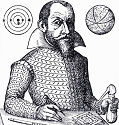 Meanwhile, news of the invention spread quickly and by 1609 models of the device could be purchased in Paris and Frankfurt markets. One example, which seemed to have a cracked lens, was displayed by a dutchman in the autumn fair of 1608 at Frankfurt am Mayn. The device was shown to one Philip Fuchs von Bimbach who tried to purchase it from its dutch seller, "however the dutchman demanded a tremendous price" so von Bimbach refrained from its purchase. However, von Bimbach did assist the German scientist Simon Marius (engl. Mayr, 1573-1624) in reproducing a working copy of the device, as Galileo would do in April or May of 1609, upon hearing a description of the instrument retold to him. Seen right is an image of Simon Marius courtesy Wikipedia. [6]
Meanwhile, news of the invention spread quickly and by 1609 models of the device could be purchased in Paris and Frankfurt markets. One example, which seemed to have a cracked lens, was displayed by a dutchman in the autumn fair of 1608 at Frankfurt am Mayn. The device was shown to one Philip Fuchs von Bimbach who tried to purchase it from its dutch seller, "however the dutchman demanded a tremendous price" so von Bimbach refrained from its purchase. However, von Bimbach did assist the German scientist Simon Marius (engl. Mayr, 1573-1624) in reproducing a working copy of the device, as Galileo would do in April or May of 1609, upon hearing a description of the instrument retold to him. Seen right is an image of Simon Marius courtesy Wikipedia. [6]-fn3
Growth of the Telescope
Both a great mathematician and astronomer, Galileo is rightfully remembered not only for his design improvements to the telescope but also as the first observer of the solar system to employ such an instrument. — K. Pinkela, 2008
The Growing Telescope, Hevelius, Bradley and Cassini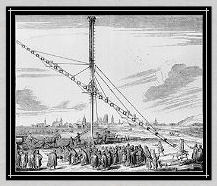 By today's standards the new telescopic device was a rather crude instrument and later designs were not noted for their stability due to the lengthening of the tubes which contained the magnifying lenses. As inventors continued their efforts to increase magnification, they also increased the telescopes' size; twenty-five, fifty, one-hundred feet and more. One such example, shown at left, was built by the German—Polish astronomer Johannes Hevelius, an instrument that measured an incredible 158 feet in length! Hevelius was the son of a wealthy brewer in Danzig, a city on the Baltic Sea. After studying law and traveling in Europe, he settled in his hometown to work as a brewer and local politician. However, astronomy had recently taken off in popularity, and Hevelius found himself fascinated by the sky. He constructed his first observatory in his house in 1641, but quickly realized his small instruments were not good enough to perform the precise observations he needed to reach his goal of creating a star catalog. He eventually built successive telescopes that increased the focal length of the lenses until he had reached the furtest limits of what could practically be handled, his 150-foot-plus long instrument. The 150-foot telescope was too long to be encased in an expensive and heavy iron tube, and a paper tube would have fallen apart. So Hevelius arranged the lenses in a wooden trough, suspended the whole thing from a 90-foot pole, and used ropes, pulleys, and a team of workmen to operate it from the ground. Yet, Hevelius' devices were effective and he was able to note in 1659: [7]
By today's standards the new telescopic device was a rather crude instrument and later designs were not noted for their stability due to the lengthening of the tubes which contained the magnifying lenses. As inventors continued their efforts to increase magnification, they also increased the telescopes' size; twenty-five, fifty, one-hundred feet and more. One such example, shown at left, was built by the German—Polish astronomer Johannes Hevelius, an instrument that measured an incredible 158 feet in length! Hevelius was the son of a wealthy brewer in Danzig, a city on the Baltic Sea. After studying law and traveling in Europe, he settled in his hometown to work as a brewer and local politician. However, astronomy had recently taken off in popularity, and Hevelius found himself fascinated by the sky. He constructed his first observatory in his house in 1641, but quickly realized his small instruments were not good enough to perform the precise observations he needed to reach his goal of creating a star catalog. He eventually built successive telescopes that increased the focal length of the lenses until he had reached the furtest limits of what could practically be handled, his 150-foot-plus long instrument. The 150-foot telescope was too long to be encased in an expensive and heavy iron tube, and a paper tube would have fallen apart. So Hevelius arranged the lenses in a wooden trough, suspended the whole thing from a 90-foot pole, and used ropes, pulleys, and a team of workmen to operate it from the ground. Yet, Hevelius' devices were effective and he was able to note in 1659: [7]
In the sword of Orion are three stars quite close together. In 1656 I chanced to be viewing the middle of one of these with a telescope, instead of a single star twelve showed themselves (a not uncommon occurrence). Three of these almost touched each other, and with four others shone through the nebula, so that the space around them seemed far brighter than the rest of the heavens, which was entirely clear and appeared quite black, the effect being that of an opening in the sky through which a brighter region was visible. [8]
 The record for the longest, however, belongs to James Bradley (shown right), a British astronomer who, in 1722, used a telescope that was over 212 feet in length! Appointed to succeed Edmund Halley as astronomer royal In 1742, Bradley's most memorable discovery regarded the aberration of light which was communicated to the Royal Society in January 1729 (Phil. Trans. XXXV, 637). The observations upon which it was founded were made at Samuel Molyneux's house on Kew Green. Image of James Bradley courtesy NNDB website. [9]
The record for the longest, however, belongs to James Bradley (shown right), a British astronomer who, in 1722, used a telescope that was over 212 feet in length! Appointed to succeed Edmund Halley as astronomer royal In 1742, Bradley's most memorable discovery regarded the aberration of light which was communicated to the Royal Society in January 1729 (Phil. Trans. XXXV, 637). The observations upon which it was founded were made at Samuel Molyneux's house on Kew Green. Image of James Bradley courtesy NNDB website. [9]But lengthening telescopes were not the only problem that plagued the early designs. It should be remembered that the manufacturing of optical lenses, while a common industry in Europe regarding spectacles, was another story when it came to telescopes; grinding the lenses was a laborious task, the results imperfect. During the infancy of the telescope, while many ground their own lenses, they were faced with the difficulties of finding clear and homogeneous glass for the lenses. The glass was full of little bubbles and had a greenish tinge (caused by the presence of iron impurities). This was a problem that troubled telescope makers for centuries. In an article discussing the historical mechanics and early telescope designs, the Astronomical Observatory of Bologna notes:
The glass used in these early instruments was of very poor quality and chromatic and spherical aberration worsened the images. Despite this astronomers continued to press for ever more powerful instruments. Before the invention of mirror lenses and the perfecting of the reflecting telescope, the only way to improve the actual telescope seemed to be to increase the focal length. The result was tubes so long they threatened to bend under their own weight and supports that became increasingly unstable; tubes were built over thirty metres long, up to Hevelius's gigantic telescope (focal length 45 metres) and the so-called "aerial telescopes" (over 60 metres), achieved by simply placing the object lens in an elevated position and collecting the image in the eyepiece, without using tubes. All at the expense of using these long instruments reasonably. [10]
Cumbersome though they may have been, they were still functional and seemed to do pretty much what the maker and user intended them to do—the magnification of distance objects:
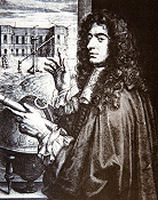 Despite their awkwardness, longer telescopes with larger lenses helped make more and more discoveries. Saturn's ring was identified by Christiaan Huygens (1629-1695) who, with his brother Constantine, constructed telescopes that were 12, 23, and even 123 feet long. Christiaan Huygens also developed an aerial telescope, an eyepiece joined by a taut thread to the main telescope, that was itself perched on a tall pole. [Aerial telescope. image 14, p. 143 Hoskin] Many of Saturn's moons were discovered by Jean Dominique Cassini (1625-1712), who used telescopes as long as 17, 34, 100, and 135 feet. It seemed every time Cassini made a longer telescope, he discovered another moon! Cassini also saw that Saturn really had two rings. He mounted one of his long telescopes on a water tower that he had the Paris Observatory move to the observatory grounds at great expense. Shown at left is Jean-Dominique Cassini (1625-1712), Italian-born French astronomer, painted by Durangel, 1879. [11]
Despite their awkwardness, longer telescopes with larger lenses helped make more and more discoveries. Saturn's ring was identified by Christiaan Huygens (1629-1695) who, with his brother Constantine, constructed telescopes that were 12, 23, and even 123 feet long. Christiaan Huygens also developed an aerial telescope, an eyepiece joined by a taut thread to the main telescope, that was itself perched on a tall pole. [Aerial telescope. image 14, p. 143 Hoskin] Many of Saturn's moons were discovered by Jean Dominique Cassini (1625-1712), who used telescopes as long as 17, 34, 100, and 135 feet. It seemed every time Cassini made a longer telescope, he discovered another moon! Cassini also saw that Saturn really had two rings. He mounted one of his long telescopes on a water tower that he had the Paris Observatory move to the observatory grounds at great expense. Shown at left is Jean-Dominique Cassini (1625-1712), Italian-born French astronomer, painted by Durangel, 1879. [11]
Galileo - Description of Invention
About ten months ago a report reached my ears that a certain Fleming had constructed a spyglass, by means of which visible objects, though very distant from the eye of the observer, were distinctly seen as if nearby... Of this truly remarkable effect several experiences were related, to which some persons gave credence while others denied them. A few days later the report was confirmed to me in a letter from a noble Frenchman at Paris, Jacques Badovere, which caused me to apply myself wholeheartedly to enquire into the means by which I might arrive at the invention of a similar instrument. This I did shortly afterwards, my basis being the theory of refraction. First I prepared a tube of lead, at the ends of which I fitted two glass lenses, both plane on one side while on the other side one was spherically convex and the other concave. — Galileo Galilei, The Starry Messenger (1610), trans. Stillman Drake, Discoveries and Opinions of Galileo (1957), pp.28-9
Appearance in the City of Venice News of the new invention spread like wildfire and like many inventions before it, the new optical instrument or telescope (the name was first used in 1611 when Galileo was inducted into the Lincean Academy) was quickly displayed to a wide audience, a sort of curio that when looked through, magnified distant objects or brought into view those blurry specks of lights in the night skies. Given the arteries of commerce that flowed throughout Europe, it wasn't long before the telescope had gained a widespread interest, examples seen by persons of all standing including one that was presented to King Henry IV of France, accquired by the French ambassador at the Hague. Within a year, inventors were manufacturing their own versions of the telescope under such names as "lookers", "Dutch trunks", "perspectives" and "cylinders", selling these to hunters and sailors in the markets of Paris, London, and Heidelberg. As the new invention found a viable market, it was only natural that it spread in and amongst the environs of Europe, eventually appearing in the city of Venice, Italy in 1609. It was here that the telescope would begin its ascent ad astra and to a seemingly endless list of scientific discoveries, all stemming out of the fact that the telescope brought to Venice not only went unsold but it really went, mysteriously. In one of those interesting asides told about the history of things: [12]
News of the new invention spread like wildfire and like many inventions before it, the new optical instrument or telescope (the name was first used in 1611 when Galileo was inducted into the Lincean Academy) was quickly displayed to a wide audience, a sort of curio that when looked through, magnified distant objects or brought into view those blurry specks of lights in the night skies. Given the arteries of commerce that flowed throughout Europe, it wasn't long before the telescope had gained a widespread interest, examples seen by persons of all standing including one that was presented to King Henry IV of France, accquired by the French ambassador at the Hague. Within a year, inventors were manufacturing their own versions of the telescope under such names as "lookers", "Dutch trunks", "perspectives" and "cylinders", selling these to hunters and sailors in the markets of Paris, London, and Heidelberg. As the new invention found a viable market, it was only natural that it spread in and amongst the environs of Europe, eventually appearing in the city of Venice, Italy in 1609. It was here that the telescope would begin its ascent ad astra and to a seemingly endless list of scientific discoveries, all stemming out of the fact that the telescope brought to Venice not only went unsold but it really went, mysteriously. In one of those interesting asides told about the history of things: [12][A]n unidentified stranger attempted to sell a looker to a politician, who referred the matter to the city's scientific adviser, Paolo Sarpi. Sarpi carefully examined it and questioned the stranger about its workings. But when the stranger mysteriously departed the city with his instrument, Sarpi went to see Galileo Galilei. Seen above left is an image of Galileo by Sarah K. Bolton from Galileo Galilei: Famous Men of Science, (New York, 1889) and is based on a portrait by Justus Sustermans that was painted in 1636. [13] -fn4
Little did anyone then suspect just how much the little "curio" was about to change centuries old scientific knowledge, shake the foundations of dogmatic beliefs and confirm to the individual who decided to point the device skyward, that the world and indeed, the universe, did not work as the majority thought it did: with the telescope, the Age of Galileo had literally arrived.
Next Page
Footnotes
1. While various archaeological surveys have found numerous samples of polished quartz, there has been little evidence to show that they were used as a means of improving vision. The oldest lens artifact is the Nimrud lens, which is over three thousand years old and dating back to ancient Assyria. The writings of Pliny the Elder (23—79 A.D.) also show that burning-glasses were known to the Roman Empire and mentions what is arguably the earliest use of a corrective lens: Nero was said to watch the gladiatorial games using an emerald.
2. This is the same Jordan of Pisa or Giordano da Pisa (c. 1255 — 19 August 1311) who was a Dominican friar and preacher of some note and reputation; he is also known by the name Giordano da Rivalto. Jordan studied the use of preaching for evangelisation. He pioneered the use of the Tuscan language for preaching and lecturing, which helped establish it as the foremost among the vernaculars of Italy He was said to have preached five times a day and many notes, written by those in attendance, have survived. See also: B. Giordano da Pisa, O. P., (d. in 1311) CATHOLIC ENCYCLOPEDIA: Pisa, listing the natives and persons of the Archdiocese of Pisa.
3. It is both interesting and relevant to note that a third possible claimant to the telescope's invention was one Sacharias Janssen who was away at the Frankfurt Fair trying to turn his model into cash. This seems to be the same "Dutchman" that attempted to sell his device to Philip Fuchs von Bimbach for such a tremendous price that its purchase was declined. It is also the very same device that von Bimbach described to the German scientist Simon Marius. See The Galileo Project at Rice University and compare to source reference [5] below: Louis Bell, The Telescope pp.4—5.
4. Other sources record that Paolo Sarpi wrote to Galileo or that a report had spread throughout the city, heard by Galileo, of the device's import. See for example: Louis Bell's The Telescope, 1922, p.7; Mary Allan-Olney's The private life of Galileo, 1870 p.49; J J O'Connor and E F Robertson's article, Galileo Galilei, 2002 (School of Mathematics and Statistics University of St Andrews Scotland) "Galileo received a letter from Paolo Sarpi telling him about a spyglass that a Dutchman had shown in Venice...". Finally, Gailieo himself relates, in the Starry Messenger (Sidereus Nuncius), that in April 1610:
About ten months ago a report reached my ears that a certain Fleming had constructed a spyglass by means of which visible objects, though very distant from the eye of the observer, were distinctly seen as if nearby...A few days later the report was confirmed by a letter I received from a Frenchman in Paris, Jacques Badovere, which caused me to apply myself wholeheartedly to investigate means by which I might arrive at the invention of a similar instrument.
Chapter One
Dangerous Concept, Dangerous Times: Galileo, Kepler and the Church
Page 2
© Legal Copyright Notice:
Unless otherwise stated, all images, screen shots, electronic materials including instructional, software, scripts and web pages referred to herein or incorporated by reference are copyrighted © A Universe in Time. None of the content herein may be reproduced or copied in any manner from this website without the prior written permission of above indicated copyright holder(s). All images and orginal works of the author(s) used within the above or foregoing web pages are for the sole purpose of information and display at A Universe in Time website and have been used with the kind permission of the respective owner(s).
BACK TO THE TOP